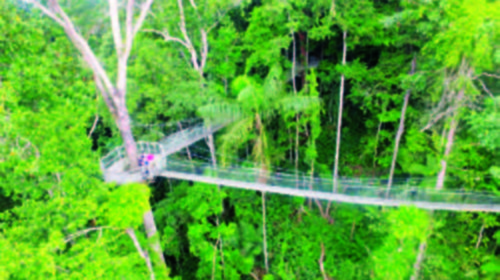
Reflecting on the floods, savannah fires, depleted forests and contaminated waters that presently pervade Guyana, President David Granger has opined that the Iwokrama International Centre for Rainforest Conservation must change if it was to survive the coming decades.
He shared this position during the 30th anniversary of the organisation, which manages one million hectares of Guyana’s rainforest, set aside particularly for preservation.
Speaking at the ceremony at the Umana Yana, Georgetown on Saturday evening, Granger stated that Guyana’s biodiversity was more precious than the boon of oil and must be protected from further threats which cause irreparable physical damage.
As such, the Iwokrama Rainforest must breathe under a new covenant and adapt to change in order to fight extinction. He added that a document was in the making, which would speak to education and research, becoming a cornerstone for students in the botany and wider biology fields.
“Iwokrama must change to survive; it can no longer subsist under the old covenant which played a pivotal role over the past 30 years … Dinosaurs became extinct because they could not adapt to change. If organisms cannot change, they cannot survive. Change is imperative and indispensable for improvement. Iwokrama will not survive unless it adapts to the challenges imposed by climate change. Change is taking place at a rapid pace and is improving our knowledge of the environment. Institutions which do not prepare for the continuous changes in the environment will become irrelevant,” the President insisted.
He added Iwokrama would not be allowed to become a lifeless monument or museum or, worst, a timber grant or gold mine, adding that a new covenant would be crafted to ensure Iwokrama’s survival and success, in perpetuity. The new covenant will be functional rather than ornamental.
The Iwokrama covenant was sealed in November 1995 with the signing of the agreement between the Guyana Government and the Commonwealth Secretariat for the establishment of the Iwokrama International Centre for Rainforest Conservation and Development.
This agreement had a central aim of: “undertaking research, training and the development of technologies which will promote the conservation and the sustainable and equitable use of tropical rain forests in a manner that will lead to lasting ecological, economic and social benefits to the people of Guyana and to the world in general.”
However, the President divulged that this mission has not been fully accomplished by the Centre due to other global situations in the past which diverted funding.
“The Centre, as a result, has been unable to access adequate assets to execute its mission fully. The Centre is here to stay, however, and remains relevant to the national responses to local and global environmental threats. It is part of the solution to the adverse effects of climate change – such as the extreme weather; rising sea levels, precipitous levels of biodiversity loss, and diminishing freshwater supplies – to which the world is seeking solutions. It is immense, impressive, irreplaceable; it provides priceless environmental and ecological services to the earth and remains vital to the protection of the world’s biodiversity, fresh air and freshwater supplies,” he expressed.
There are plans to place another two million hectares under conservation, in keeping with the commitments under the Paris Agreement and to enforce a ban on the exportation of wildlife. According to Granger, policies aimed at lowering deforestation rates and enhancing timber monitoring will also be announced.
Guiana Shield
He reminded that Guyana is at the centre of the Guiana Shield, regarded as the last remaining tract of pristine rainforest in the world. The Shield spreads across a distance of 2.7 million square kilometres and across other countries such as Suriname, Brazil, Venezuela, and Colombia within the South American continent.
As it relates to revenues from the oil and gas resources, Granger said funds would be injected into the protection of the protected areas, including Iwokrama and the Konashen Protected Area. The latter comprises 7000 square kilometres which was accredited to the Queen’s Commonwealth Canopy.



